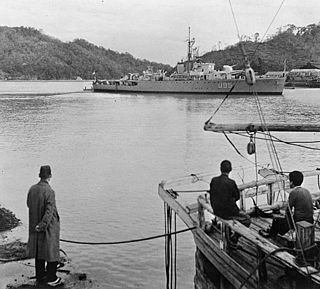
HMS Black Swan, was the name ship of the Black Swan-class sloops of the Royal Navy. This class was admired for its sea-going qualities.

The Royal Indian Navy (RIN) was the naval force of British India and the Dominion of India. Along with the Presidency armies, later the Indian Army, and from 1932 the Royal Indian Air Force, it was one of the Armed Forces of British India.

The Black Swan class and Modified Black Swan class were two classes of sloop of the Royal Navy and Royal Indian Navy. Twelve Black Swans were launched between 1939 and 1943, including four for the Royal Indian Navy; twenty-five Modified Black Swans were launched between 1942 and 1945, including two for the Royal Indian Navy; several other ships were cancelled.

Maritime powers in the Indian subcontinent have possessed navies for many centuries. Indian dynasties such as the Chola Empire used naval power to extend their influence overseas, particularly to Southeast Asia. The Marakkar Navy under Zamorins during 15th century and the Maratha Navy of the Maratha Confederacy during the 19th and 18th centuries fought with rival Indian powers and European powers. The East India Company organised its own private navy, which came to be known as the Bombay Marine. With the establishment of the British Raj after the Indian Rebellion of 1857, the small navy was transformed into "His Majesty's Indian Navy", then "Her Majesty's Indian Marine", and finally the "Royal Indian Marine".

HMS Wild Goose, pennant number U45, was a Black Swan-class sloop of the Royal Navy. She was one of several ships of that class that took part in the famous "six in one trip" in 1943.

HMS Magpie, pennant number U82, was a Royal Navy Modified Black Swan-class sloop launched in 1943 and broken up in 1959. She was the seventh Royal Navy ship to bear the name. She was reclassified as a frigate in 1947, receiving a new pennant number F82. The ship was the only vessel commanded by Prince Philip, Duke of Edinburgh, who took command on 2 September 1950, when he was 29.

HMIS Narbada (U40) was a Modified Bittern class sloop, later known as the Black Swan class, which served in the Royal Indian Navy (RIN) during World War II.

HMIS Sutlej (U95) was a modified Bittern-class sloop, later known as the Black Swan class, which served in the Royal Indian Navy (RIN) during World War II.

HMIS Kistna (U46) was a Black Swan-class sloop which served in the Royal Indian Navy (RIN) during World War II.
HMIS Cauvery, pennant number U10, was a Black Swan-class sloop which served in the Royal Indian Navy (RIN) during World War II.
HMIS Jumna (U21) was a Black Swan-class sloop, which served in the Royal Indian Navy (RIN) during World War II.
HMIS Kathiawar (J155) was a Bangor-class minesweeper built for the Royal Navy, but transferred to the Royal Indian Navy (RIN) during the Second World War.

HMIS Hindustan (L80) was a Folkestone-class sloop which served in the Royal Indian Navy (RIN) during World War II. Her pennant number was changed to U80 in 1940.
HMIS Oudh (J245) was a Bangor-class minesweepers built for the Royal Navy, but transferred to the Royal Indian Navy (RIN) during the Second World War.
HMIS Punjab (J239) was a Bathurst-class minesweeper which served in the Royal Indian Navy (RIN) during World War II.
HMIS Lawrence (L83) was a sloop, commissioned in 1919 into the Royal Indian Marine (RIM).

HMS Hart was a modified Black Swan-class sloop of the Royal Navy. She saw service as a convoy escort during the Second World War, seeing service in the Atlantic, Mediterranean and Far East in 1945. She also took part in the Korean War in 1950 and 1951.

HMS Peacock was a modified Black Swan-class sloop of the Royal Navy. She was built for service as a convoy escort during the Second World War, serving in the arctic and Atlantic convoys. After the Second World War she saw service in the Mediterranean. She was scrapped in 1958.

HMS Cygnet was a modified Black Swan-class sloop of the Royal Navy. She was laid down by Cammell Laird, Birkenhead on 30 August 1941, launched on 28 July 1942 and commissioned on 1 December 1943, with the pennant number U38.














